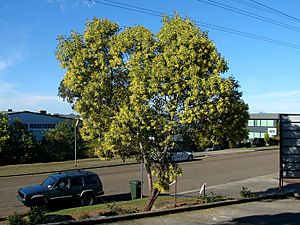Curracabah facts for kids
Quick facts for kids Curracabah |
|
|---|---|
 |
|
| Scientific classification | |
| Genus: |
Acacia
|
| Species: |
concurrens
|
 |
|
| Occurrence data from AVH | |
The Curracabah (scientific name: Acacia concurrens) is a type of shrub or small tree. It is also known as black wattle. You can find it growing naturally in Queensland, which is in eastern Australia.
This plant used to be called Acacia cunninghamii. Its new name, Acacia concurrens, describes how the main veins on its leaves (called phyllodes) come together. It looks a lot like other Acacia plants, such as Acacia leiocalyx and Acacia disparrima.
Contents
What Does Curracabah Look Like?
This plant can grow up to 10 meters (about 33 feet) tall, but it's usually smaller.
Leaves and Bark
- Its leaves are actually flattened leaf stems called phyllodes. They are shiny green and shaped a bit like an oval, but wider at the top.
- These phyllodes can be up to 16 centimeters (about 6 inches) long.
- The Curracabah has grey-black bark that looks cracked and stringy.
- Its branches are strong and have sharp edges.
Flowers and Seeds
- Curracabah blooms between March and September.
- It produces bright yellow, rod-shaped flowers. These flowers grow in pairs where the leaves meet the stem.
- The flower spikes are usually 3.5 to 11 centimeters (about 1.4 to 4.3 inches) long.
- After flowering, it forms long, narrow seed pods. These pods are slightly bumpy and shaped like a half-circle.
- The pods are 5 to 10 centimeters (about 2 to 4 inches) long.
- Inside the pods are brownish-black seeds. They are oval-shaped and about 3.5 to 4.5 millimeters long.
Where Does Curracabah Grow?
The Curracabah plant is found only in a specific area of Australia. It grows from southeastern Queensland down to northern New South Wales.
Habitat
- It is common in areas near the coast.
- You can find it on hillsides or flat areas.
- It prefers sandy or stony-sandy soils, often where there is shale rock underneath.
- Curracabah often grows as a smaller plant under taller Eucalyptus trees in forests.

All content from Kiddle encyclopedia articles (including the article images and facts) can be freely used under Attribution-ShareAlike license, unless stated otherwise. Cite this article:
Curracabah Facts for Kids. Kiddle Encyclopedia.
